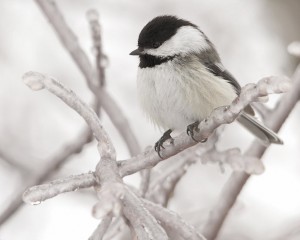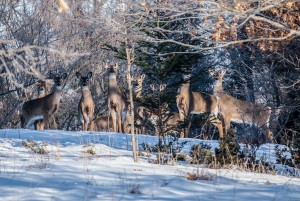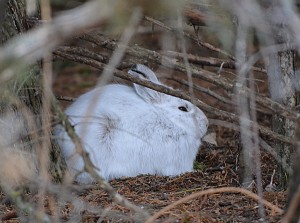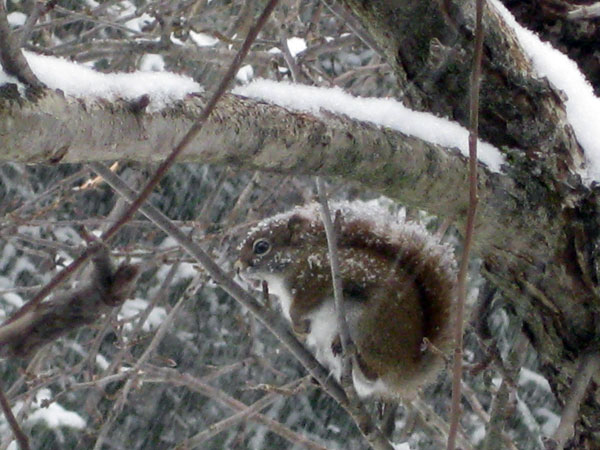Winter’s “mood swings” are hard on everything
There are times when a person might want everything at once. The picnic where you take a hot dog off the grill and load it up dripping with onions, kraut, chipotles, mustard, ketchup or whatever else will fit on the bun before the bread gives way. But maybe not too often, because you might have to pay for it with heartburn, not to mention pictures your kids post of you trying to eat the everything-dog. Moderation has its benefits.
Someone ought to tell that to Old Man Winter, or Mother Nature, or whoever is in charge of the show these days. Even though it is still early in the season, we have been served, almost on a weekly basis, generous helpings of everything winter has to offer. It’s as if Nature glanced at its weather playlist and hit the “shuffle” button, and then went on vacation, probably somewhere warm.
I’m not claiming it has been a hard winter thus far, just a rather temperamental one. We go from zero to fifty above, then back to single digits all in one week, each transition punctuated by freezing rain, sleet and high winds. I like a few plot twists in a story, some unexpected events, but the reruns can get tedious.
Following each meteorological mood swing, I hear people comment how confusing the weather makes them. You plant spring bulbs one day, shovel snow the next, then have to lace up the crampons the day after that because it rained and then suddenly froze. If you think it’s annoying for us humans, who have the luxury of retreating into our warm homes, imagine how the animals feel.

Chickadees go hungry when ice covers their food supply. Photo: Mike Tidd, Creative Commons, some rights reserved
Freezing rain can really mess things up for resident songbirds. Chickadees are not able to break apart the birch and alder catkins they depend on for food. Nuthatches can’t extract seeds from pine and spruce cones which are encased in ice. This type of weather is normal, of course, but glaze events occur more often when the weather changes its mind every few days. An ice crust on top of the snow can make it hard for grouse and turkeys, and deer as well, to find browse. Of course, good old-fashioned snow presents challenges.
Retired Wildlife Biologist Ken Kogut, formerly with the New York State Department of Environmental Conservation, explains that “the depth and character of snow has a profound impact on wildlife.” We can probably understand how deep snow might keep deer from finding food, in addition to hampering their movement. As the snowpack gets sixteen or more inches deep, their bellies drag, and it’s hard for them to raise their legs high enough to take a step.

Deer may have to choose between struggling through deep snow and finding food. Photo: FOHRA, Creative Commons, some rights reserved
In these conditions, deer will “yard up,” finding shelter in a conifer stand. These places have much less snow on the ground because the dense canopy intercepts a lot of the snowfall. The problem is that there is very little to eat, and they may starve to death.
Kogut points out that while it might not be as obvious, in harsh winters a lot of turkeys also starve to death. Typically they forage by walking, scratching at the duff to unearth food, but they are unable to do this in deep snow. They will seek berries that may remain on shrubs and trees like highbush cranberry and hawthorn, but this food is limited.
Yet some creatures depend snow for survival. Small rodents, meadow voles in particular, fare well in the world under the snow, which science nerds call the subnivean environment. They’re safe from birds of prey, their most significant predators, and can find plenty of weed seeds and other vegetation on which to feed. Unfortunately this sometimes includes the bark of small tree trunks, much to the disappointment of orchardists and homeowners. However, in parts of the Adirondacks, the American (pine) marten hunts rodents under the snow.

A snowshoe hare’s nifty camo does little good in the thaw. Photo: ND Parks and Recreation Dept., Creative Commons, some rights reserved
When the white stuff piles up, showshoe hares, with their furry oversize feet, have an advantage over predators such as dainty-footed foxes. But with alternate-week thaw cycles, that advantage melts away. And how about species who change into white for the winter? Camouflage doesn’t work so well for ermines and hares when fickle weather keeps swapping out the background color.
Winter raptors like rough-legged hawks and snowy owls just shift their hunting grounds depending on conditions. The very cold winter of 2014-14 saw many more such birds of prey in northern NY because as harsh as it was here, it was even worse in northern Ontario and Quebec. So far this winter I’ve seen a lot of red-tailed hawks that apparently forgot to migrate, as well as great blue herons, but not as many raptors such as snowy owls and great gray owls from northern latitudes.
The effects of winter weather are not limited to fur and feather. According to Bud Ziolkowski of Saranac Lake, a former Paul Smith’s College instructor with a background in fisheries biology, a small number of fish typically die as a result of winter conditions every year. In winters with a long period of ice cover, though, oxygen in the water can become so depleted that large numbers of fish may suffocate.
Oxygen enters the water in two ways, through surface contact with air, and from aquatic plant photosynthesis. Thick ice cuts off sunlight to plants, and of course there is no contact between water and air. Fish aren’t the only ones using oxygen under the ice—decaying vegetation in the bottom sediments (the benthos, to science eggheads) use up far more than the fish do.
So far we have had thundersnow, or a lightning-enhanced snowstorm, but at least Mother Nature hasn’t given us a winter tornado. But I’m knocking on wood here.
Paul Hetzler is a horticulture and natural resources educator with Cornell Cooperative Extension of St. Lawrence County.








